And a final round.
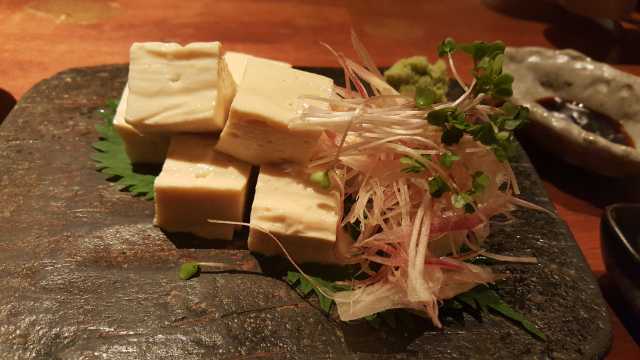
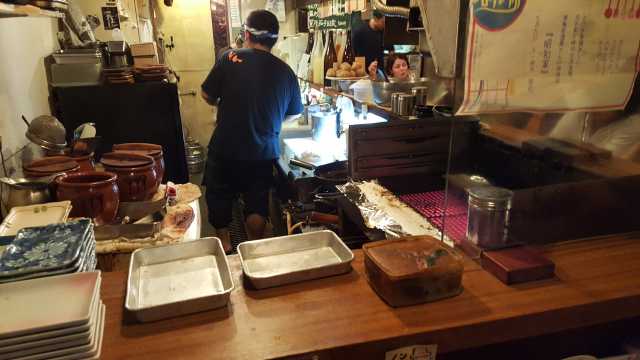
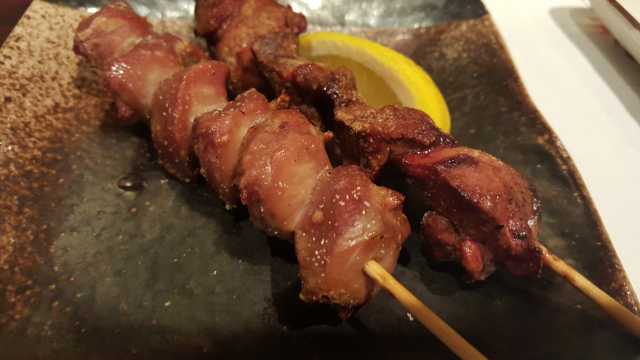
A simply amazing and beautiful thread. The notes and photos are gorgeous. I have never been to Japan but it is very high on my “to do list.” I may have to reprioritize my travel plans.
Cheers!
Marshall ![]()
Amazing and beautiful indeed, I’m not ready for this end.
Wonderful. Intriguing. Beguiling.
Must go.
I’ve got a lot more notes to write up - now just need to find the time! It’s a wonderful, weird, warm, alien place. We are addicted. Though I must admit that coming home to someplace you can get a decent pizza is also pretty great. ![]()
Great thread and thanks for taking the time to share and post.
I know you were probably referring to home pizza…have you been to Beddia Pizza, yet?
Suzanne - no, we haven’t been there yet. If we don’t have pizza at home, it’s usually at Nomad Pizza, which is right up the street. It’s not transcendent, but it’s good and close and they know us well. Beddia is close to where our new house will be, though, so it’s likely we’ll check it out sooner rather than later.
Sarah, your write ups are fantastic, and much appreciated. Even though I’ve been to Japan many times, I am usually traveling alone, and not nearly as daring and adventurous as you. But I’m taking notes to help rectify that in the future. Missed you by two weeks in Kyoto (then Niigata and Tokyo, all business, not very fun, and not a lot of free time to do much else, unfortunately).
Thanks again!
Thanks Alan. I’m the first to admit that my husband’s language skill really helps for being adventurous. I’m the one willing to drive on the wrong side of the road, though. ![]() I’ve only been there without him twice, and know from experience it’s much harder to wander off the beaten path alone.
I’ve only been there without him twice, and know from experience it’s much harder to wander off the beaten path alone.
I’ll get some more posted this evening, I hope.
[u]In which Sarah and Jonathan do Something Cultural – and by PURE coincidence, have a 3 kaiseki meal[/u]*
Lest you think we only eat and drink on vacation……
About an hour from Kyoto is the town of Nara, which was the old old capital, before Tokyo, before even Kyoto. If the people in Kyoto consider themselves more Japanese than everyone else, those in Nara fall even further down that spectrum. It is home to the Daibutsu, a 15 meter high bronze Buddha inside the Todai-ji Temple, which was the world’s largest wooden structure until 1998, as well as a number of other temples and shrines. It is also home to a large herd of deer, which roam freely around the park and temples. I hate the deer (they smell, and pee/crap all over the place), and could do without the crowds, but I’m a big fan of Todai-ji and the Museum of National Treasures. I am also now a fan of the beautiful and absolutely delightful Wa Yamamura, a Michelin 3 star kaiseki restaurant located on a backstreet of Nara, well away from the center of anything. It is an oasis of elegance, simplicity and peace, which radiates love of and respect for the flavors and forms of this traditional meal.
Kaiseki dining is Japanese haute cuisine, with strict principles and long history. It is highly specialized, celebrating the change of seasons, and balancing textures, flavors, colors and shapes. In areas renowned for particular ingredients, those ingredients will be featured in the kaiseki meal. To the downside, this focus can sometimes get a little monotonous (I have to admit, when every meal at every restaurant is celebrating young bamboo shoots, for instance), but the upside is more than worth it. ![]() In kaiseki, each diner is presented with a series of carefully arranged small dishes, placed one after another onto a single tray which remains in front of her for the entire meal. Formal kaiseki will generally include appetizer, a simmered dish, grilled dish, steamed dish, rice, soup, pickles and dessert, as well as other courses designed by the chef. Here is the listing from Wikipedia, which accurately reflects my experience:
In kaiseki, each diner is presented with a series of carefully arranged small dishes, placed one after another onto a single tray which remains in front of her for the entire meal. Formal kaiseki will generally include appetizer, a simmered dish, grilled dish, steamed dish, rice, soup, pickles and dessert, as well as other courses designed by the chef. Here is the listing from Wikipedia, which accurately reflects my experience:
• Sakizuke (先附?): an appetizer similar to the French amuse-bouche.
• Hassun (八寸?): the second course, which sets the seasonal theme. Typically one kind of sushi and several smaller side dishes.
• Mukōzuke (向付?): a sliced dish of seasonal sashimi.
• Takiawase (煮合?): vegetables served with meat, fish or tofu; the ingredients are simmered separately.
• Futamono (蓋物?): a “lidded dish”; typically a soup.
• Yakimono (焼物?): (1) flame-grilled food (esp. fish); (2) earthenware, pottery, china.
• Su-zakana (酢肴?): a small dish used to clean the palate, such as vegetables in vinegar; vinegared appetizer.
• Hiyashi-bachi (冷し鉢?): served only in summer; chilled, lightly cooked vegetables.
• Naka-choko (中猪口?): another palate-cleanser; may be a light, acidic soup.
• Shiizakana (強肴?): a substantial dish, such as a hot pot.
• Gohan (御飯?): a rice dish made with seasonal ingredients.
• Kō no mono (香の物?): seasonal pickled vegetables.
• Tome-wan (止椀?): a miso-based or vegetable soup served with rice.
• Mizumono (水物?): a seasonal dessert; may be fruit, confection, ice cream, or cake.
Kyoto is the center of the universe for kaiseki (I always tell people who ask for Japan advice to save their kaiseki experience for Kyoto rather than “wasting it” in Tokyo), and I’ve been lucky to experience some extraordinary examples over the years at places like Nakamura and Nakahigashi, as well as at ryokan such as Miyamasou and Yoyokaku. I have a predisposition to enjoy meals like this, as I prefer small, vegetable and fish-centric dishes focusing on freshness and clarity of flavor over heavy, rich, sauce-laden meals. I can enjoy those, too, just not as often. And I must admit, I’m totally in love with how beautiful great kaiseki dishes can be, especially when properly paired with Japanese ceramics and lacquerware. My husband and I are avid collectors of Japanese ceramics, especially those we can use with our own meals, so a kaiseki meal can also be, for us, a way to find new ceramic artists, as well as learn new dishes.
We’ve long known of Wa Yamamura in Nara, and have wanted to go there, but have had a hard time booking on previous trips to the area. We got lucky this time, and managed a lunch reservation at the counter. As an aside, it’s a funny thing about a lot of high-end restaurants in Japan that lunch is exactly the same menu as dinner, but consistently costs less. Why? (Shrug) Because lunch is always less expensive than dinner, everyone knows that….We took a cab from the main temple complex across town to a non-descript residential neighborhood, where this jewel of a restaurant is nestled away. The entrance is unmistakable: on an otherwise dull block, a simple, willowy wooden sign and a huge arrangement of branches and flowers marks the door. I read that the chef does all his own flower arranging, too, which is a skill owed great respect in Japan.
When the doors finally opened (we were a little early), we were graciously ushered in and seated at the counter by (I believe) chef’s wife, who was to be our main server throughout the meal. Once she got over the initial trepidation about serving the westerners (they don’t many, we later learned), she was friendly and easy to talk to, even joking with us. High-end Japanese restaurants are often hesitant about foreigners, not because of any racial issues (there are, sadly, still some of those as well), but because they are afraid of doing something wrong and not being able to serve you properly, so they would sometimes rather just avoid it entirely. Jonathan’s Japanese goes a long way in helping with that, and simply being open and relaxed will make a huge difference as well. At Wa Yamamura, they had thoughtfully provided a handwritten English menu of what we’d be eating. We began with a dish of abalone steamed in sake, udo (something like Japanese white asparagus), matsutake mushrooms and lemon vinegar. Alongside was served a small dish of homemade chestnut wine. The mushroom and abalone dish was ethereal and earthy at the same time, and possessed of perfect balance. Each bite was delicate and flavorful, and the textures of the individual elements were separately honored. It turned out to be our favorite dish of the meal. Even the chestnut wine was good!
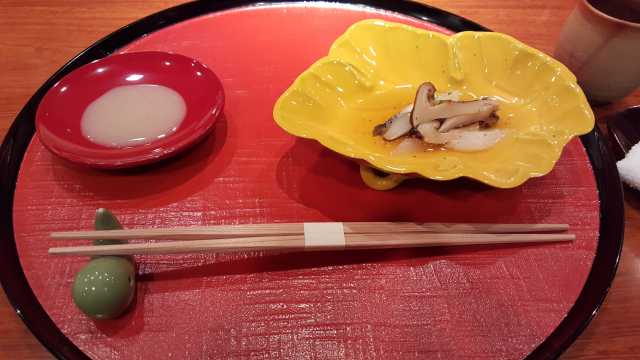
We followed this amazing offering with a soup of conger eel, matsutake mushrooms, prawns, ginko nut, and herbs, served from a small teapot warmed on an individual brazier. This presentation is called dobin mushi and it is the traditional first of the season preparation for matsutake - there are other dobin mushi, but this one is an iconic example. In keeping with the spirit of kaiseki, this was simple, elegant, complex and delicious. These dishes demand your attention – not because they hit you over the head with richness and flavor, but because they invite you to listen to them as one does to a single, perfect bell ringing. The flavors and textures build in your mouth and in your mind. You stop talking, bend you head a bit, maybe close your eyes. You forget your sake, your tea, the person sitting next to you, and get lost in the spell of the moment of each bite. Forgive the flowery language – the food can’t be described without poetry. Next came scorpion fish sashimi, conger eel pressed sushi, and an incredibly beautiful full sashimi course including chu-toro, ama ebi, engawa (flounder fin) and ika (squid) with shiso blossoms. After the sashimi, one of the most beautiful hassun trays I’ve seen, with seasonal vegetables and shellfish, and tofu with uni – tiny bites of 10 or so different small dishes, presented at once to show the abundance of the season.
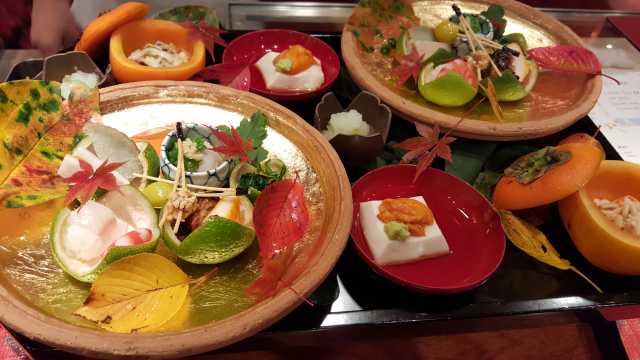
Our grilled dish (again on an individual brazier) was ayu, or sweet fish, done in two ways and full of roe.
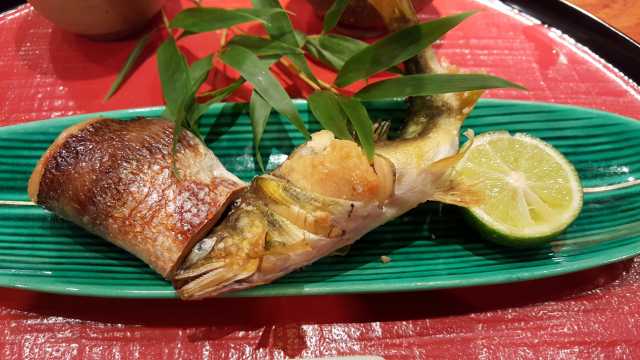
Then yuba with crab and shimeji mushrooms and citrus jelly. Then steamed root vegetables with spinach and mochi. Then rice with chestnuts. Then red miso soup with tiny mushroom caps. Then finally a dessert of fruit (persimmon, melon and muscat grapes) in barely sweet jelly. It was an embarrassment of riches, a walk through a Japanese market, along a stream with leaves tumbling down, a celebration of the end of spring and beginning of fall. For all the abundance, it wasn’t too much food. We were full, but not stuffed, and easily handled the bancha they gave us to finish – the second flush of Sencha green tea harvested between spring and fall.
As wonderful as the food was – and it was wonderful indeed – the overall experience reached another level due to the warmth and personal attention of the staff and chef. Most of the dishes in our meal were prepared in the kitchen and brought out to the counter perfectly arranged including water drops shimmering on the lacquerware (I caught a glimpse of our server with a tiny spray bottle, spritzing the tray.) The only courses prepared in front of us were the sushi plates, which chef himself assembled. He stood right in front of us, behind the counter throughout the meal, making easy conversation with the two older Japanese women seated to our left, who seemed to be regulars. He was humble, slightly shy, relaxed, adorable, friendly and funny. We knew from our research the he, like us, is a fan of Yakimono (literally “cooked things,” but used to refer to ceramics) so when presented with a selection of ochoko (sake cups) to use during our meal, we eschewed our normal request for wine glasses and each chose one of the beautiful vessels he offered. Jonathan and I both correctly identified the origin of our choices – that is, the style of pottery and thus location of the potter - mine being Shigaraki and his Hagi. Chef smiled and laughed and said “Japanese people don’t know this sh-t!” He took a few more pieces out of the cabinets to show us, and we happily exchanged stories of favorite artists, favorite sites to visit, and uses to which we put various vessels.
As the meal went on, and service was slowing down, chef took out a large squash and proceeded to break it down, then create the incredibly delicate spirals which garnished one of the early courses. We’d originally thought they were citrus twists and set them aside, until our server told us they were edible. It was one of the most impressive displays of knife skills I’ve ever seen, and the fact that he, a 3 star chef, was standing there preparing his mise en place for the evening service while chatting with customers, struck me deeply. I can’t imagine any American celebrity chef doing that, or not many anyway. With very few exceptions, this has been my experience almost everywhere in Japan, and particularly outside of Tokyo - the earnest and utterly transparent manner in which Japanese chefs behave towards their customers and their food. It means something to them that you’ve come so far to eat at in their restaurant. They want you to enjoy yourself, are curious about you, and display nothing of the arrogance and hauteur of so many western chefs at the same level. Sure, there are forms that will be observed no matter what – seeing you out and bowing until you are out of sight – so it’s possible they are just very good actors. But I don’t think so.
I loved every minute of our time at Wa Yamamura. In the canon of great kaiseki meals I’ve experienced, a few others might surpass it for pure culinary merit, but so many other things made this meal unique and special, it’s tough to compare. In what seems to have been a theme of this trip, the price was considerably less than similar meals at this level in Kyoto. Seeking out the best restaurants away from the dining epicenters has much to recommend it.
I think I held my breath during the entire story–thank goodness it wasn’t longer! Lovely.
Sorry, it did get a little long…
No, not too long! Keep it coming! Great, great notes on the food, somehow you choose the prose to match the experience, and your pictures are lovely. You have a real talent for this–I’d think you could publish this kind of thing if you are so inclined.
Never.
It was a beautiful read, thx again.
And dang…
I wanna be like you guys when I grow up.
Just catching up and wow - what an amazing experience heightened by your ability to convey every last detail with passion.
I’m obsessed with dough and bread, so was very interested in learning more about Tatsuru Rai. Here’s a great reddit thread where the top comment gives a detailed explanation of what he’s actually doing in this video. Must read and watch, to me.
Great video and comment - thanks! That is exactly what we saw him doing and it was magical. Almost the way a pot just suddenly emerges from the hands of a potter with clay on the wheel, the dough moved through each stage as if under a spell. And he was the picture of zen calm and concentration. He does this for every bowl ordered, nothing is done in advance. True mastery of a craft.